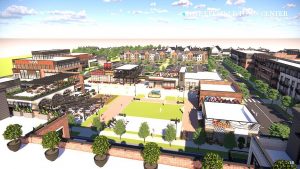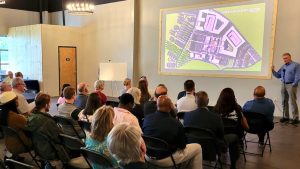Motorists traveling through the heavily-used intersection at Grady Avenue and Beauregard Avenue in Fayetteville began using a two-month detour of the area beginning June 1.
Once re-opened by the start of school on Aug. 8, the new intersection will have a look unlike anything seen before in Fayetteville. The old four-way stop will have been replaced with a large, heavily landscaped roundabout designed to keep traffic moving in every direction.
Director of Public Services Don Easterbrook said the Grady Avenue/Beauregard Avenue roundabout is designed to promote the free flow of traffic at one of the city’s busiest local intersections. Grady Avenue is a frequently used connector to Ga. Highway 54 and Ga. Highway 85 enabling motorists to bypass the often congested downtown area.
Easterbrook said the city’s aim in installing a roundabout as opposed to a traffic signal involved more than the long-standing problem of traffic flow at the intersection.
“The purpose and need of this project is to improve traffic conditions and safety at this busy intersection while preserving the historic and residential land use characteristics of the surrounding area. The use of a traffic signal in this area, which promotes a more commercial style land use, was considered but declined by the city,” said Easterbrook.
Easterbrook said the city is also working on a conceptual design of the Grady Avenue/Hwy. 85 intersection if the increased traffic flow from the roundabout necessitates changes at that intersection. The conceptual design includes a southbound right turn lane onto Hwy. 85 South, lengthening of the Grady Avenue northbound left turn lane onto Hwy. 85 North and alternatives to the timing of the traffic signal.
Aside from being “round” to keep traffic flowing, how is the roundabout designed and how will it fit into the local landscape?
Easterbrook said there will be an interior grassed island 47 feet in diameter immediately surrounded by a 17-foot-wide drivable truck apron for vehicles with limited turning radius. The truck apron will be constructed of stamped concrete that will resemble cobblestone, according to Integrated Science & Engineering consultant Jason Walls.
The outer asphalt ring, at 18 feet wide, will be for the regular traffic flow.
In all, the large radius of the roundabout from the center of the island to the outside of the asphalt ring will be approximately 60 feet, Easterbrook said.
Each side of Beauregard and Grady approaching the roundabout will come with a feature not always seen with roundabouts. Traffic entering and exiting the roundabout from three of the four sides will be separated by a small triangular-shaped median, with the west side of Grady being outfitted with two small medians. Crosswalks and sidewalks will also be added to designated portions of the intersection.
Although roundabouts by their design have right turn-only lanes, Grady Avenue as it approaches the roundabout from the west will have the customary right turn lane and a second lane that splits off and travels directly into the roundabout, thereby potentially reducing the traffic back-ups so frequent on that side of the intersection.
The landscape plan for the intersection was designed by Peachtree City landscape architect Dennis Drewyer. A sampling of the grass and low-lying, flowering plants that will be installed in the center of the roundabout include hydrangeas, Knockout roses, Big Blue liriope, holly, Loropetalum azaleas and Stela d’Oro daylilies.
A number of trees and existing plants had to be removed to install the large roundabout. In their place and on each of the four sides of sides of the intersection will be a wealth of new plant material. The height of the shrubs will be kept to a minimum so as not to obstruct the view of motorists entering the roundabout area, Drewyer said.
A sampling of plants to be installed along the roundabout’s perimeter includes all the varieties in the interior island along with a large number of Indian hawthorne, Willow oak, Wax myrtle, Okame cherry, Little Gem magnolia, Dwarf Burford holly, Kousa dogwood, Blue Pacific juniper, Camelia sansqua, cryptomeria, maiden grass and sod.
Information on roundabouts from the Insurance Institute for Highway Safety (IIHS) notes than in locations where roundabouts have replaced traffic signals or stop signs there was a 39 percent decrease in traffic accidents, a 76 percent decrease in injuries from accidents and 90 percent decrease in fatalities and/or incapacitating injuries resulting from accidents.
IIHS also said vehicle delays were reduced 62-74 percent.
The proposal for the roundabout came from a 2007 Downtown Fayetteville Traffic Study. A portion of the study noted the declining effectiveness of the Grady/Beauregard intersection during peak travel hours and school-zone periods.
The bid for the $553,000 project was awarded in March. The project award went to Southeastern Site Development, Inc. with a bid amount of $552,772.39. The Southeastern bid was the second lowest of seven bids received. Southeastern won the bid after consulting engineering firm Integrated Science and Engineering reviewed the bids and found that the low bidder had omitted some of the bid items.
The roundabout project is funded through the city’s Impact Fee Fund. Easterbrook said there will be a projected shortfall of $191,000 that will be covered by remaining funds in the Lafayette Ave. Extension project that was recently put on hold.












Leave a Comment
You must be logged in to post a comment.